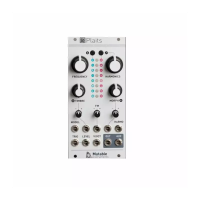This part LFO vs voice LFO distinction sounds confusing, and there is actually little
documentation about it. Most classic analog synthesizers do not have one LFO circuit per
voice, so their behaviour is accurately simulated by the use of part LFOs. Some VAs, like
the access Virus, use voice LFOs. On the Waldorf Blofeld, each LFO is a voice LFO by
default and can be turned into a part LFO through the use of the sync setting.
•
lfo/eg: Selects the LFO / envelope generator to edit. The settings shown on the
page are relative to the selected LFO / EG. If you are wondering if there is such
thing as a “filter envelope” and “VCA envelope”... Yes, by default env2 is mapped to
cutoff and env3 to the VCA ; but this can be changed in the modulation matrix by
patching pranksters.
•
rate: LFO rate. The first values (1/1 to 1/96) are note values relative to the global
tempo (or to an external MIDI clock). For example, if set to 1/4, the LFO will play
one cycle every quarter note. The other values are increasing frequencies, from
0.06 Hz (0) to 100 Hz (127).
•
wave (waveform): LFO waveform. A list of LFO waveforms is given below.
•
trig (trigger): LFO/envelope synchronization mode. free leaves the LFO free-
running. env>>lfo resets the phase of the LFO everytime a new note is played.
lfo>>env retriggers the corresponding envelope generator everytime the LFO
completes a cycle.
•
attk (attack): Envelope attack time, from 1ms to 66s.
•
deca (decay): Envelope decay time (same times as for attack).
•
sust (sustain): Envelope sustain level.
•
rele (release): Envelope release time (same times as for attack).
•
Here is a list of LFO waveforms:
•
tri: Triangle.
•
sqr: Square.
•
s&h: Sample & hold (random value).
•
ramp: Ascending ramp (use a negative modulation amount in the modulation matrix
to get a descending ramp modulation).
•
sine to stp2: Wavetable LFOs. These LFOs are read from a wavetable containing
many interesting waveshapes.
sine to stp2 LFO wavetable
23

